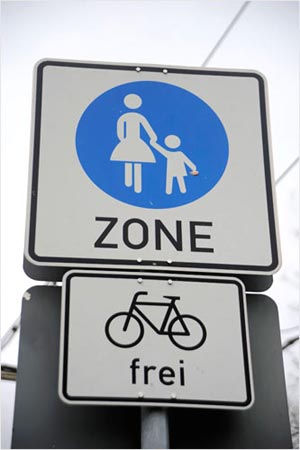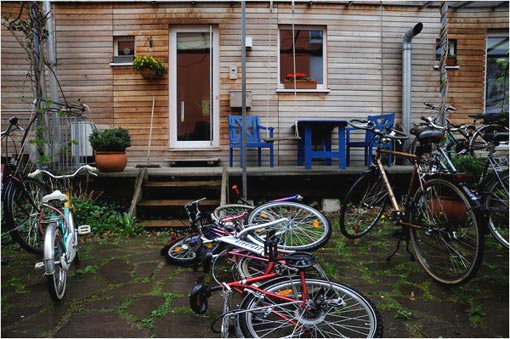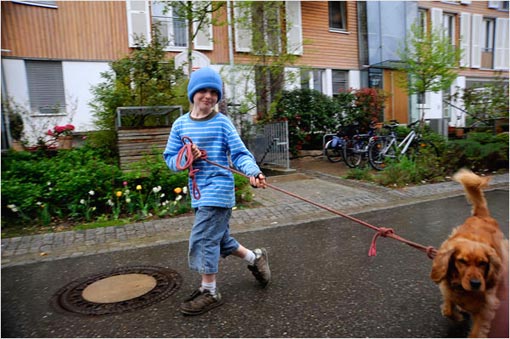You are hereBlogs / WcP.Tomorrows.History's blog / Vauban's streets are nearly "car-free": on outskirts of Freiburg, Germany - suburban pioneers give up their cars
Vauban's streets are nearly "car-free": on outskirts of Freiburg, Germany - suburban pioneers give up their cars

(quote)
VAUBAN, Germany - Residents of this upscale community are suburban pioneers, going where few soccer moms or commuting executives have ever gone before: they have given up their cars.
Street parking, driveways and home garages are generally forbidden in this experimental new district on the outskirts of Freiburg, near the French and Swiss borders. Vauban’s streets are completely “car-free” - except the main thoroughfare, where the tram to downtown Freiburg runs, and a few streets on one edge of the community. Car ownership is allowed, but there are only two places to park — large garages at the edge of the development, where a car-owner buys a space, for $40,000, along with a home. As a result, 70 percent of Vauban’s families do not own cars, and 57 percent sold a car to move here. Vauban, completed in 2006, is an example of a growing trend in Europe, the United States and elsewhere to separate suburban life from auto use, as a component of a movement called “smart planning.”

Automobiles are the linchpin of suburbs, where middle-class families from Chicago to Shanghai tend to make their homes. And that, experts say, is a huge impediment to current efforts to drastically reduce greenhouse gas emissions from tailpipes, and thus to reduce global warming. Passenger cars are responsible for 12 percent of greenhouse gas emissions in Europe - a proportion that is growing, according to the European Environment Agency - and up to 50 percent in some car-intensive areas in the United States.
While there have been efforts in the past two decades to make cities denser, and better for walking, planners are now taking the concept to the suburbs and focusing specifically on environmental benefits like reducing emissions. Vauban, home to 5,500 residents within a rectangular square mile, may be the most advanced experiment in low-car suburban life. But its basic precepts are being adopted around the world in attempts to make suburbs more compact and more accessible to public transportation, with less space for parking. In this new approach, stores are placed a walk away, on a main street, rather than in malls along some distant highway.

“All of our development since World War II has been centered on the car, and that will have to change,” said David Goldberg, an official of Transportation for America, a fast-growing coalition of hundreds of groups in the United States - including environmental groups, mayors’ offices and the American Association of Retired People - who are promoting new communities that are less dependent on cars. Mr. Goldberg added: “How much you drive is as important as whether you have a hybrid.”
Levittown and Scarsdale, New York suburbs with spread-out homes and private garages, were the dream towns of the 1950s and still exert a strong appeal. But some new suburbs may well look more Vauban-like, not only in developed countries but also in the developing world, where emissions from an increasing number of private cars owned by the burgeoning middle class are choking cities.

In the United States, the Environmental Protection Agency is promoting “car reduced” communities, and legislators are starting to act, if cautiously. Many experts expect public transport serving suburbs to play a much larger role in a new six-year federal transportation bill to be approved this year, Mr. Goldberg said. In previous bills, 80 percent of appropriations have by law gone to highways and only 20 percent to other transport.
In California, the Hayward Area Planning Association is developing a Vauban-like community called Quarry Village on the outskirts of Oakland, accessible without a car to the Bay Area Rapid Transit system and to the California State University’s campus in Hayward. “People in the U.S. are incredibly suspicious of any idea where people are not going to own cars, or are going to own fewer,” said David Ceaser, co-founder of CarFree City USA, who said no car-free suburban project the size of Vauban had been successful in the United States.

In Europe, some governments are thinking on a national scale. In 2000, Britain began a comprehensive effort to reform planning, to discourage car use by requiring that new development be accessible by public transit. “Development comprising jobs, shopping, leisure and services should not be designed and located on the assumption that the car will represent the only realistic means of access for the vast majority of people,” said PPG 13, the British government’s revolutionary 2001 planning document. Dozens of shopping malls, fast-food restaurants and housing compounds have been refused planning permits based on the new British regulations.
(unquote)
Photos courtesy of Martin Specht / The New York Times
Original Source: NY Times


















